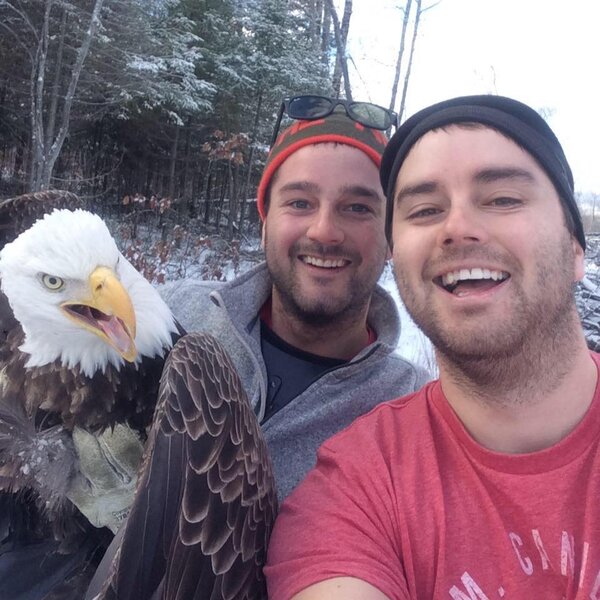Canadian brothers free trapped bald eagle, take selfie with it
Loading...
Two brothers from Sudbury, Ontario, became Internet stars this week after they rescued a bald eagle from a trap on Tuesday and set it free, but only after taking a once-in-a-lifetime selfie with the giant raptor.
Michael and Neil Fletcher, both in their 20s, said they were hunting grouse when they spotted the national bird of the country to the south, with one of its talons caught in a trap placed by fur trappers, CBC News reports.
"It was relieving to see that it was still alive," Neil Fletcher told CBC. "I knew we had to do something right away," he said.
A video that Michael Fletcher posted on his Facebook page shows the brothers and their dog cautiously approaching the bird and trying several times to throw a sweatshirt over its head to calm it down so they could free it from the trap.
"At first the eagle was a bit nervous to have my brother and myself there," Neil said.
"As soon as he realized we were trying to help he kind of calmed down a little bit. His head would kind of move back and forth to look at us, but that was the most he'd do," he said.
It took nearly 4 minutes for the brothers to free the eagle from the trap and – after posing for the now famous selfie – to release the formidable predator and watch it fly off.
Sudbury ornithologist Chris Blomme told the CBC that freeing the bald eagle, with its sharp beak and claws, was the right thing to do.
"I think it's really great the Michael and Neil took the gumption to actually try and deal with the bird,” which, he said, is much more common to see soaring through the sky after becoming nearly extinct in the 20th century.
Congress first identified the bald eagle as “threatened with extinction” in 1940. By the 1970s, after suffering from decades of deforestation, hunting by people who thought the birds threatened livestock, and poisoning by the widely used insecticide, DDT, the birds were on the national endangered species list.
In 1963 there were 487 nesting pairs of bald eagles left, according to the US Fish and Wildlife Service, down from the 100,000 estimated to exist in the late 18th century.
The banning of DDT in 1972, and decades of conservation efforts, helped the species to recover and finally come off the endangered list in 2007.
But the birds are still protected by national laws that prohibit killing, selling, or otherwise harming eagles, their nests, or eggs.
The Fletcher brothers said they had never seen an eagle up close and were struck by its grandeur.
"Me and my brother, we've always been in the bush, always been hunters. And we've always had a lot of respect for bald eagles," Neil told the CBC.
"We were just really amazed – and still are," he said.







